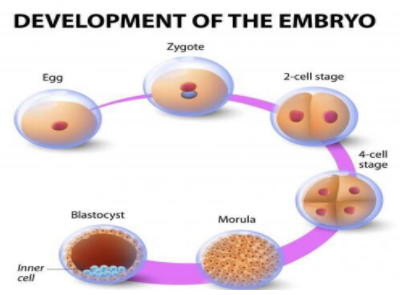
Cleavage in mammals-
A. Holoblastic equal
B. Holoblastic unequal
C. Superficial
D. Discoidal
Answer
498k+ views
Hint: During the process of embryo development process of cleavage takes place. After 30 hours of fertilization first cleavage is completed. This Cleavage furrow passes from the animal vegetal axis and centre of zygote. It devised the zygote completely into two blastomeres. In mammals, including humans, cleavage divisions are among the slowest in the animal kingdom. The cleavage division is asynchronous.
Complete answer:
Holoblastic equal:- the type of cleavage in which the segmentation line passes through the entire egg, dividing it completely into two equal halves. This type of division occurs in mammals. Hence the option is correct.
Holoblastic, unequal:- the cleavage in which segmentation line divides egg into two unequal halves. This does not occur in mammals. So this option is correct.
Superficial:- it is a type of meroblastic cleavage which occurs in centrolecithal eggs of insects. So this option is not correct.
Discoidal:- the line of segmentation does not pass completely through the egg. It occurs in eggs of birds. Hence this option is incorrect.
Our required answer is A. that is holoblastic and equal.

Note: Second cleavage is completed after 60 hours of fertilization. It is meridional at right angles to the first one. It is completed earlier in one of two blastomeres resulting in a transient 3-celled stage. Third cleavage is horizontal forming 8 blastomeres. The number of resultant blastomeres increased following arithmetic progression.
Complete answer:
Holoblastic equal:- the type of cleavage in which the segmentation line passes through the entire egg, dividing it completely into two equal halves. This type of division occurs in mammals. Hence the option is correct.
Holoblastic, unequal:- the cleavage in which segmentation line divides egg into two unequal halves. This does not occur in mammals. So this option is correct.
Superficial:- it is a type of meroblastic cleavage which occurs in centrolecithal eggs of insects. So this option is not correct.
Discoidal:- the line of segmentation does not pass completely through the egg. It occurs in eggs of birds. Hence this option is incorrect.
Our required answer is A. that is holoblastic and equal.

Note: Second cleavage is completed after 60 hours of fertilization. It is meridional at right angles to the first one. It is completed earlier in one of two blastomeres resulting in a transient 3-celled stage. Third cleavage is horizontal forming 8 blastomeres. The number of resultant blastomeres increased following arithmetic progression.
Recently Updated Pages
Master Class 9 General Knowledge: Engaging Questions & Answers for Success

Master Class 9 English: Engaging Questions & Answers for Success

Master Class 9 Science: Engaging Questions & Answers for Success

Master Class 9 Social Science: Engaging Questions & Answers for Success

Master Class 9 Maths: Engaging Questions & Answers for Success

Class 9 Question and Answer - Your Ultimate Solutions Guide

Trending doubts
Give 10 examples of unisexual and bisexual flowers

Draw a labelled sketch of the human eye class 12 physics CBSE

Differentiate between homogeneous and heterogeneous class 12 chemistry CBSE

Differentiate between insitu conservation and exsitu class 12 biology CBSE

What are the major means of transport Explain each class 12 social science CBSE

Draw a diagram of a flower and name the parts class 12 biology ICSE




